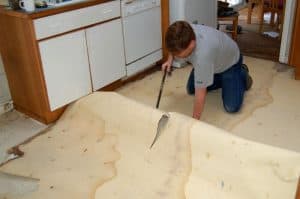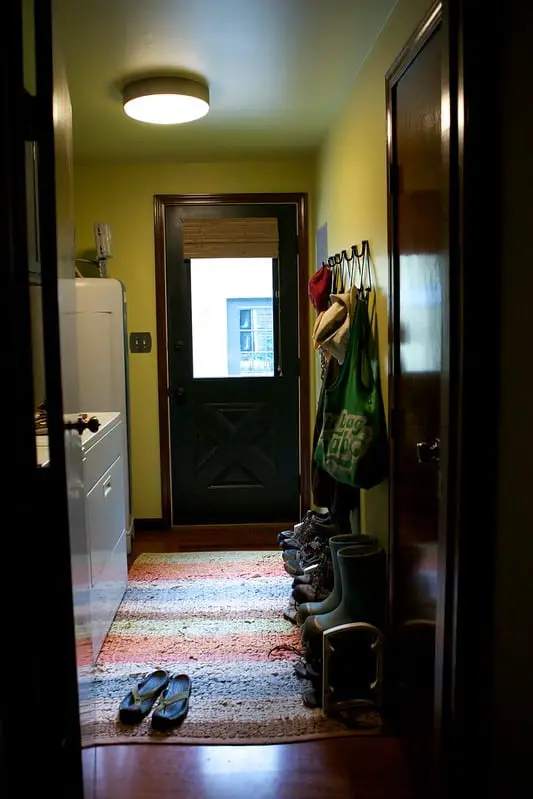If your washer or dryer is prone to dancing all over the room while in operation, chances are you have already thought of installing them on wooden cubes or something similar.
Salespersons tend to recommend carpet, but that’s not something an expert would ask you to install.
If the floor in the laundry room is prone to getting slippery, chances are you have been thinking beyond carpets.
A rug may easily come as a second fiddle to a carpet because they are normally more rugged and made from a wide range of materials.
They are also easier to maintain in wet environments, especially if you choose those made of rubber.
So, Can You Put A Rug Under A Washer And Dryer?
Generally, no, but it can depend. Some specialized dryer/washer mats can be used. Never use an average rug. For dryers, the material used to make the mat should support tumble drying, otherwise, it could pose a fire risk. Nevertheless, laundry rooms are seldom designed to accommodate a carpet or rug on the floor. Still, your choices will be limited to certain materials.
Why Would You Want To Utilize A Rug In A Laundry Room?
1. Laundry Rooms Can Be Messy Places
The laundry room is often a messy place sometimes with water spilling over and detergents pouring on the floor.
Clearly, this is not a place you’d bring shag carpeting or install expensive hardwood flooring.
The floor area under your dryer and washer must be built to stand up to three things:
- staining
- wear and tear
- moisture.
Ask any interior designer and they will recommend vinyl for your laundry floor and that is not necessarily a limiting option.
Subsequently, the question is, what’s the perfect covering for the laundry room’s floor beneath the washer and dryer?
Washer Drain Pans
If your main worry is water leakage from the washer – which may destroy the floor if allowed to leak for a long time unchecked – then you should consider washer drain pans over a carpet or rug.
Washer drain pans offer a cheap and less troublesome way to stop the water from leaking from the washer and damaging your floor.
A drain pan is installed to slide under the washing machine and provide the first barrier against accidental spillage, leaks, and anything else that might drip down from the washer.
2. Health hazards
While average rugs and carpets may look great initially, they will absorb the moisture and foster the growth of mold and lots of bacterial colonies.
The mold simply reduces the appearance of the mat but if left unchecked for a long time, it may build up to significant levels that may cause respiratory problems to your family.
Also, damp rugs and carpets provide optimum conditions for the growth of fungus and bacteria that may end up on the handles of the washer/dryer from where you might pick and spread them to the rest of the home.
They can end up being a health hazard to your family.
Hardwood is yet another flooring material you’d be advised against.
In almost every room in your house, hardwood can be a fantastic choice. Unfortunately, as you probably understand already, moisture and hardwood flooring simply don’t mix.
Also, if you go ahead to install any wood flooring in the laundry room, you will be compelled to do replacement sooner than you may think.
Some Rubber Mats Are OK For Washers
Rubber mats are better suited to handle the wet conditions under your washer better than the average carpet or rug.
But you will need to replace or wipe off the algae once in a while if the room is too wet.
Dryer/washer rubber mats are manufactured from near-indestructible, waterproof, heavy-duty rubber complete with a textured top surface to cut on vibrations, sliding, and ‘walking’ of your washer and dryer.
Additionally, most dryer/washer floor mats you will find are anti-microbial and non-absorbent.
What If You MUST Install A Washer On The Carpet?
Installing the washer on a regular carpet is not the most attractive thing any keen homeowner would want to do, but you can try it if that’s all you must do.
It is actually possible to put a washer on a carpet, but you need to approach it with care.
Your choices will be limited to specially designed rubber and bamboo carpets.
Start by putting plywood on the floor and then add the washing machine drips pan. This way, almost no dripping water will reach the carpet below the washer.
You might want to make changes to the installation location. Bets locations for washers and even dryers on an appropriately carpeted floor are:
In the Entryway (Mudroom)
Any home’s mudroom can make a perfect installation for a padded or carpeted washer and dryer.
On the exact Same Floor As Your Bedroom
It doesn’t hurt to have a laundry room on one floor alog with your bedroom(s).
Right next to your Kitchen
Some kitchens are designed to feature a closet or pantry close to them.
Can You Put Your Dryer On A Rug Or Carpet?
In one word – “NO.” Never put your tumble dryer on a rug or carpet, unless it is tumble drying-friendly. A dryer put directly on an average carpet or rug has a higher risk of getting hot at the bottom and even catching fire depending on how long you would leave it to run. Only put items below/on your tumble dryer if you can establish that those items are good for tumble drying. Materials that aren’t suitable for tumble drying will pose a fire risk when tumble dried.
So What Kind of Flooring Do You Need in Your Laundry Room?

There are numerous options.
Porcelain and ceramic tiles are classic flooring materials for laundry rooms since they are easy to clean, durable, and waterproof if you install them in the right way.
1. Vinyl
Vinyl’s inherent characteristics make it competent for the protection of even the moistest floors you could imagine.
Its impermeability is outstanding.
More than all other rooms in the home, your laundry room is more likely to be exposed to standing water for some time, which can permanently ruin wool carpeting, laminate, and even hardwood flooring.
Vinyl also comes with impressive durability, and that is important in any high-traffic area of your home, not just the laundry room.
Still, vinyl is inexpensive to acquire – and most of the time, you won’t need to hire a failed contractor to install the vinyl floor for you.
The only prerequisites required for installation are clean and flat subfloor and one or two free days:
Kinds of Vinyl Flooring
All original vinyl floorings, such as its linoleum predecessors, are sold in 6-foot and 12-foot width.
You can choose to glue it to your subfloor or purchase a product equipped with a padded backing, perfect for simple flat laying without glue.
This kind of flooring is designed to function well on both wood and concrete and subfloors. Vinyl tiles need to be glued down.
If you don’t like the idea of messing your hands with a gooey adhesive, you can purchase them pre-glued.
Even better, you can purchase vinyl planks that will either fit perfectly together with your pre-attached glued strips or just snap together like average laminate boards.
Still, planks are a better choice if you are looking for a not-so-perfect subfloor because they must not be glued down to function.
2. Low-Pile Carpeting and Tile Carpeting
As we mentioned before, ceramic tiles perform well on laundry room floors.
They are waterproof and durable, but they are the hardest to install especially if you compare them to vinyl flooring.
The whole job requires that you prepare the subfloor thoroughly and include the addition of a thin layer of dry backer board to reduce tile movements and cracking.
Still, if you require texture and extra in your laundry room, you must not avoid carpeting altogether.
You’re allowed to select from a wide range of low-pile varieties – think “office” or commercial or carpeting – that feel easy on feet, are water-resistant, and comfortable for small children.
3. Paint the Subfloor
Perhaps the most durable and waterproof covering you could add to your concrete or plywood subfloor may be no covering at all.
You can simply opt to paint it with one color of latex floor enamel.
Alternatively, you can choose to create a pleasant pattern with several colors for a small fraction of the total cost of adding a floor covering.
Even better, the job requires zero special tools, besides a floor finish applicator and paintbrush.
- Preparation includes careful and thorough cleaning and – for the plywood subfloors of your choice – sanding and coating with a floor primer to guarantee paint adhesion.
- Let the paint cure, then add two coats of a clear polyurethane floor finisher to make the floor more resistant to impacts and moisture.
- Easily replaceable throw mats and rugs or mats may provide impressive foot cushioning while you are doing the laundry but, again, you will need to choose your material carefully.
Conclusion
Can you put a rug under a washer and dryer?
Generally, no, but it can depend. Some specialized dryer/washer mats can be used.
Never used an average rug or carpet average.
For dryers, the material used to make the mat should support tumble drying, otherwise, it could pose a fire risk.
Nevertheless, laundry rooms are seldom designed to accommodate a carpet or rug on the floor.

